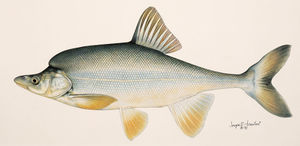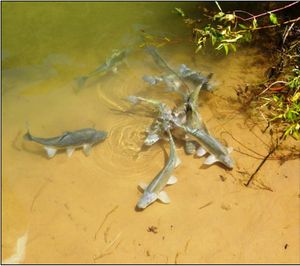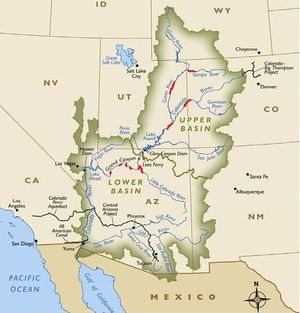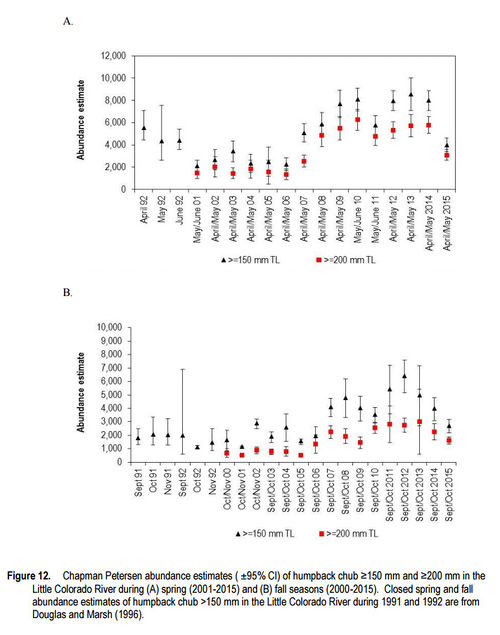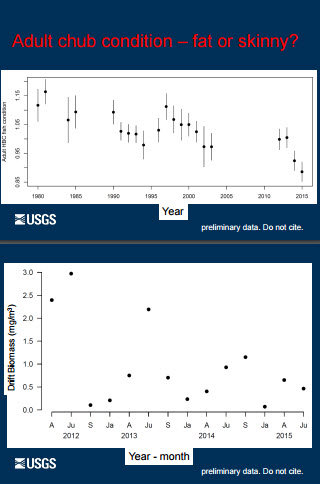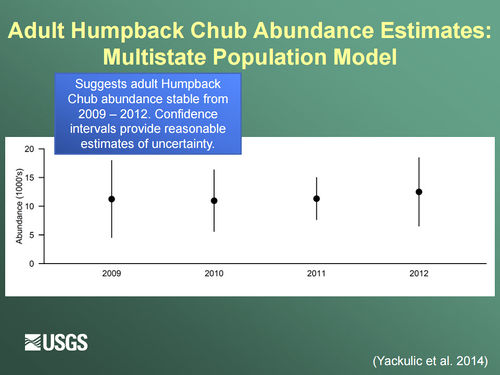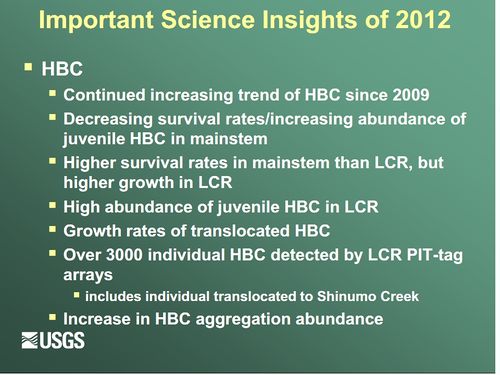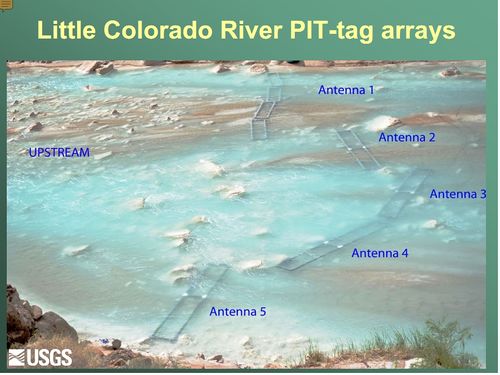Difference between revisions of "Humpback Chub Page"
Cellsworth (Talk | contribs) |
Cellsworth (Talk | contribs) |
||
| Line 58: | Line 58: | ||
|style="color:#000;"| | |style="color:#000;"| | ||
| − | + | This is an estimate of humpback chub coming into the LCR to spawn. The decline in 2015 coincides with a decline in chub condition and a decline in the trout population (remember trout and chub eat the same things and are considered competitors). This may be an indication of skip-spawning in 2015 and remaining in the mainstem, not an actual decline in population. | |
[[File:2016LCRhbcAbundanceEst.jpg|500px]] | [[File:2016LCRhbcAbundanceEst.jpg|500px]] | ||
| − | + | Body condition of humpback chub has been declining with the decline in macroinvertebrates in the drift. Note that most of the drift occurs in the summer when macroinvertebrate production is high. This decline in macroinvertebrate production coincides with the population expansion and subsequent decline in the rainbow trout population indicating competition between rainbow trout and humpback chub. <br> | |
[[File:HBCcondition drift.jpg|600px]] | [[File:HBCcondition drift.jpg|600px]] | ||
| − | + | Humpback chub numbers in Grand Canyon have been increasing since the early 2000s. | |
[[File:HBCpopEst ASMR2011.jpg|500px]] | [[File:HBCpopEst ASMR2011.jpg|500px]] | ||
| + | The Multistate Population Model separates the LCR chub from the mainstem chub in estimating population size. | ||
[[File:HBCpopEst MultiStateModel09 12.jpg|500px]] | [[File:HBCpopEst MultiStateModel09 12.jpg|500px]] | ||
| Line 76: | Line 77: | ||
[[Image:Little Colorado River PIT-tag arrays.jpg|500px]] | [[Image:Little Colorado River PIT-tag arrays.jpg|500px]] | ||
| − | *[[Media:RValdez Talus shoreline habitat used by HBC.doc| | + | *[[Media:RValdez Talus shoreline habitat used by HBC.doc| *Paper on how talus shoreline habitat is used by humpback chub]] |
|} | |} | ||
| Line 93: | Line 94: | ||
*[http://www.usbr.gov/uc/envdocs/ea/gc/nnfc/Appdx-C-BA.pdf 2011 Biological Assessment for Nonnative Fish Control Downstream from Glen Canyon Dam] as a result of the new HFE protocol | *[http://www.usbr.gov/uc/envdocs/ea/gc/nnfc/Appdx-C-BA.pdf 2011 Biological Assessment for Nonnative Fish Control Downstream from Glen Canyon Dam] as a result of the new HFE protocol | ||
*[http://www.coloradoriverrecovery.org/documents-publications/foundational-documents/recoverygoals/HBC5-yearStatusReview.pdf 2011 Humpback chub 5-year Review: Summary and Evaluation] | *[http://www.coloradoriverrecovery.org/documents-publications/foundational-documents/recoverygoals/HBC5-yearStatusReview.pdf 2011 Humpback chub 5-year Review: Summary and Evaluation] | ||
| + | *[[Media:141029 USFWS HBC Downlsting.pdf |Humpback chub downlisting criteria]] | ||
*[[Near Shore Ecology (NSE) Study]] of the fall steady flow test | *[[Near Shore Ecology (NSE) Study]] of the fall steady flow test | ||
*[https://www.usbr.gov/uc/envdocs/bo/FinalGCDBO2-26-08.pdf 2008 Biological Opinion] for HFEs, the fall steady flow test, non-native fish removal, and trout suppression flows | *[https://www.usbr.gov/uc/envdocs/bo/FinalGCDBO2-26-08.pdf 2008 Biological Opinion] for HFEs, the fall steady flow test, non-native fish removal, and trout suppression flows | ||
| Line 98: | Line 100: | ||
*[http://www.nationalparkstraveler.com/2006/02/colorado-chub-recovery-plan-tossed-out Judge dismisses 2002 Humpback Chub Recovery Goals] in [http://cdn.ca9.uscourts.gov/datastore/opinions/2012/09/17/11-16326.pdf Grand Canyon Trust vs USBR Ruling] | *[http://www.nationalparkstraveler.com/2006/02/colorado-chub-recovery-plan-tossed-out Judge dismisses 2002 Humpback Chub Recovery Goals] in [http://cdn.ca9.uscourts.gov/datastore/opinions/2012/09/17/11-16326.pdf Grand Canyon Trust vs USBR Ruling] | ||
*[http://www.fwspubs.org/doi/suppl/10.3996/082012-JFWM-071/suppl_file/10.3996_082012-jfwm-071.s12.pdf 2002 Humpback Chub Recovery Goals] | *[http://www.fwspubs.org/doi/suppl/10.3996/082012-JFWM-071/suppl_file/10.3996_082012-jfwm-071.s12.pdf 2002 Humpback Chub Recovery Goals] | ||
| − | |||
*[https://www.fws.gov/southwest/es/arizona/Documents/Biol_Opin/93167_GlenCanyonOperations.pdf 1995 Biological Jeopardy Opinion] for implementation of the MLFF alternative | *[https://www.fws.gov/southwest/es/arizona/Documents/Biol_Opin/93167_GlenCanyonOperations.pdf 1995 Biological Jeopardy Opinion] for implementation of the MLFF alternative | ||
*[https://www.fws.gov/southwest/es/arizona/Documents/RecoveryPlans/Humpback_Chub_1990.pdf 1990 Humpback Chub Recovery Plan] | *[https://www.fws.gov/southwest/es/arizona/Documents/RecoveryPlans/Humpback_Chub_1990.pdf 1990 Humpback Chub Recovery Plan] | ||
Revision as of 14:53, 8 July 2016
|
Description The humpback chub is a relatively small fish by most standards – its maximum size is about 20 inches and 2.5 pounds. By minnow standards it is a big fish, though not like the giant of all minnows – the Colorado pikeminnow. Humpback chub can survive more than 30 years in the wild. It can spawn as young as 2 to 3 years of age during its March through July spawning season. Although the humpback chub does not have the swimming speed or strength of the Colorado pikeminnow, its body is uniquely formed to help it survive in its whitewater habitat. The hump that gives this fish its name acts as a stabilizer and a hydrodynamic foil that helps it maintain position. The humpback chub uses its large fins to “glide” through slow-moving areas, feeding on insects that become trapped in water pockets.
Today, five self-sustaining populations of humpback chub occur in the Upper Colorado River Basin. Two to three thousand adults can occur in the Black Rocks and Westwater Canyon core population in the Colorado River near the Colorado/Utah border. Several hundred to more than 1,000 adults may occur in the Desolation/Gray Canyon core population in the Green River. Populations in Yampa and Cataract canyons are small, each consisting of up to a few hundred adults. The largest known population of humpback chub is in the Lower Colorado River (LCR) Basin in the Grand Canyon -- primarily in the LCR and its confluence with the main stem of the Little Colorado River. In 2009, the U.S. Geological Survey announced that this population increased by about 50 percent from 2001 to 2008 to between 6,000 and 10,000 individuals. |
| --- | Fish Species of the Colorado River in Lower Glen Canyon and Grand Canyon | --- |
|---|
